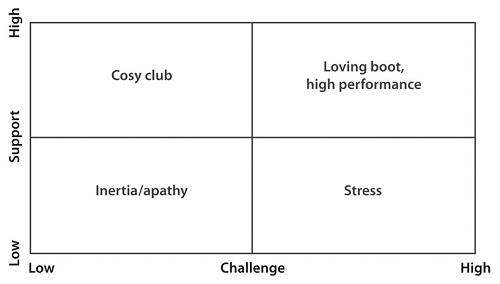Ian Day and John Blakey continue their series on challenging leadership. This time the focus is on goal setting.
Goal setting is a crucial part of any organisation. Goals provide clarity. When people have goals they have the focus to align action with corporate strategy. Many of us will be familiar with SMART goals (Specific, Measurable, Attainable, Relevant and Timebound) which are frequently used as a way to set personal objectives during appraisals. The SMART acronym is simple to understand and memorable. But are SMART goals missing something, are they truly motivational? Line managers could move beyond SMART by setting courageous goals that are exciting, stimulating and create a step change for individuals and organisations.
SMART goals draw heavily on the resources of the left-brain; they are logical, rational and sequential. The implication is that SMART goals often fail to engage and are not exciting. A recent US survey of 4000 workers across 397 organisations "Are SMART Goals Dumb" by Leadership IQ found that SMART goals all too often act as impediments to (and not enablers of) bold action and actually encourage mediocre performance. SMART goals are risk averse and encourage people to remain in their comfort zone.
Courageous goals move beyond SMART goals as they tap into the creative resources of the right brain, involving excitement, imagination, wonder and adventure. Courageous goals are transformational, they lead to a feeling of pride, and a legacy is created. However as they are audacious, the possibility of failure is greater than with SMART goals. Maybe this is why we see few courageous goals as we fear failure.
To bring this to life here are some examples of SMART goals with the courageous alternative:
SMART: Increase sales by 15%.
Courageous: Close the largest deal ever made.
SMART: Improve efficiency by 10%.
Courageous: A ten times improvement in efficiency.
SMART: Increase the share price of our pharmaceutical company by 10%.
Courageous: Eliminate the disease of malaria from the world by 2015.
So how can leaders use courageous goals with their team members? This is achieved through a balance of support and challenge. The leader can challenge the individual to take risks, to think big and to be audacious, while supporting them to overcome fears about personal limitations and the possibility of failure. This is the loving boot in which the leader provides a gentle 'kick' balancing high support and high challenge (as in the table below), which avoids the sub-optimal approaches of the other quadrants. Too much support without challenge means the goals are safe and the individual is held small. Too much challenge without support is stressful and leads to burnout.

Here is an example of a dialogue from an annual appraisal meeting at which the leader challenges a direct report to set a courageous goal:
Leader: What objectives do you want to set for yourself this year?
Direct report: A 5% increase in revenue and margin.
Leader: If your bonus was guaranteed for the next 12 months and not at risk and you were being the bravest you could possibly be, what would your target be?
Direct report: To be honest, 15%.
Leader: OK, that’s great. Let’s work with that goal for the purposes of your personal development. I understand your concerns about linking this goal to your bonus and we can have a separate conversation about this. So what else would really excite you?
Direct report: I can’t go further than that.
Leader: Looking at your numbers this year I’m confident you can. Forget the percentages, what would really excite you?
Direct report: To bring in the next big trophy client.
Leader: Now, that sounds exciting. If you did that, what would the value be?
Direct report: If it was on the same scale as Brookes, it would increase our revenue by 20% with a healthy margin, but I will need more support.
Leader: If you focus your attention on this, what will be the knock-on long-term effect?
Direct report: I won’t be able to provide the level of support I’ve been offering to some of the smaller accounts and we’ll need to look at the contracts to ensure that everything is within scope or is paid for additionally. Someone else will need to do this.
Leader: I understand what you say and this sounds a target that I would be excited about and it will focus my attention. I also hear what you say about resources, so let’s agree that your objective will be to bring in the next trophy client within 12 months and you can come back by the end of next week with a business case for the resources you need. Are you up for that?
In this dialogue the leader is challenging and stretches possibilities, considering what the organisation requires given the demands of shareholders. The leader challenges the direct report four times in this short dialogue and achieves a motivational goal, whereas other leaders may not have pushed and would have accepted a lower target. A crucial point is that this is not a bullying boss pressurising a junior person into accepting unrealistic objectives. The leader provides support, believing in the potential of this individual. The leader is aware of their capability and is confident that they can deliver.
Through the balance of support and challenge courageous goals have the potential to go beyond SMART goals to transform individuals, teams and organisations.
Ian and John's book 'Challenging Coaching– Going beyond traditional coaching to face the FACTS' published by Nicholas Brealey Publishing is available on Amazon. More information and resources, including a free chapter download can be accessed via www.challengingcoaching.co.uk. This is the fourth of a monthly column on TrainingZone to explore the detail of challenging leadership.










